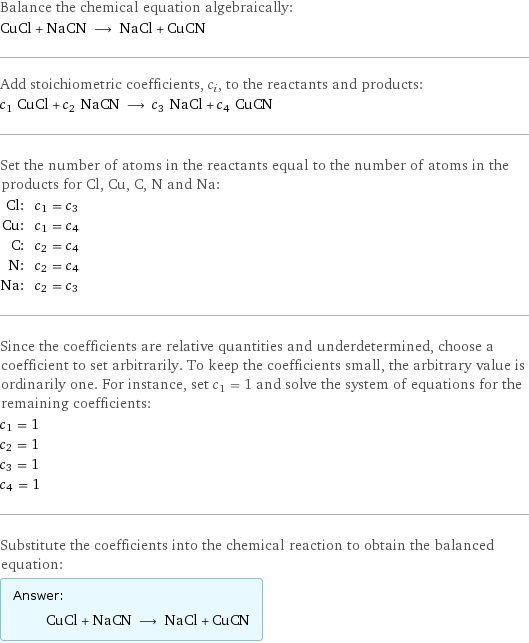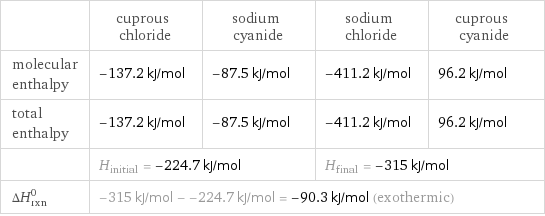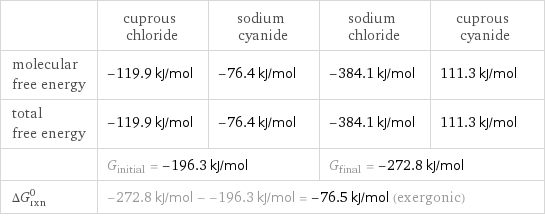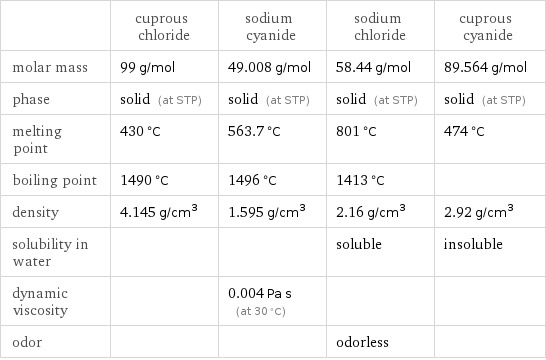Input interpretation

CuCl cuprous chloride + NaCN sodium cyanide ⟶ NaCl sodium chloride + CuCN cuprous cyanide
Balanced equation

Balance the chemical equation algebraically: CuCl + NaCN ⟶ NaCl + CuCN Add stoichiometric coefficients, c_i, to the reactants and products: c_1 CuCl + c_2 NaCN ⟶ c_3 NaCl + c_4 CuCN Set the number of atoms in the reactants equal to the number of atoms in the products for Cl, Cu, C, N and Na: Cl: | c_1 = c_3 Cu: | c_1 = c_4 C: | c_2 = c_4 N: | c_2 = c_4 Na: | c_2 = c_3 Since the coefficients are relative quantities and underdetermined, choose a coefficient to set arbitrarily. To keep the coefficients small, the arbitrary value is ordinarily one. For instance, set c_1 = 1 and solve the system of equations for the remaining coefficients: c_1 = 1 c_2 = 1 c_3 = 1 c_4 = 1 Substitute the coefficients into the chemical reaction to obtain the balanced equation: Answer: | | CuCl + NaCN ⟶ NaCl + CuCN
Structures

+ ⟶ +
Names

cuprous chloride + sodium cyanide ⟶ sodium chloride + cuprous cyanide
Reaction thermodynamics
Enthalpy

| cuprous chloride | sodium cyanide | sodium chloride | cuprous cyanide molecular enthalpy | -137.2 kJ/mol | -87.5 kJ/mol | -411.2 kJ/mol | 96.2 kJ/mol total enthalpy | -137.2 kJ/mol | -87.5 kJ/mol | -411.2 kJ/mol | 96.2 kJ/mol | H_initial = -224.7 kJ/mol | | H_final = -315 kJ/mol | ΔH_rxn^0 | -315 kJ/mol - -224.7 kJ/mol = -90.3 kJ/mol (exothermic) | | |
Gibbs free energy

| cuprous chloride | sodium cyanide | sodium chloride | cuprous cyanide molecular free energy | -119.9 kJ/mol | -76.4 kJ/mol | -384.1 kJ/mol | 111.3 kJ/mol total free energy | -119.9 kJ/mol | -76.4 kJ/mol | -384.1 kJ/mol | 111.3 kJ/mol | G_initial = -196.3 kJ/mol | | G_final = -272.8 kJ/mol | ΔG_rxn^0 | -272.8 kJ/mol - -196.3 kJ/mol = -76.5 kJ/mol (exergonic) | | |
Equilibrium constant
![Construct the equilibrium constant, K, expression for: CuCl + NaCN ⟶ NaCl + CuCN Plan: • Balance the chemical equation. • Determine the stoichiometric numbers. • Assemble the activity expression for each chemical species. • Use the activity expressions to build the equilibrium constant expression. Write the balanced chemical equation: CuCl + NaCN ⟶ NaCl + CuCN Assign stoichiometric numbers, ν_i, using the stoichiometric coefficients, c_i, from the balanced chemical equation in the following manner: ν_i = -c_i for reactants and ν_i = c_i for products: chemical species | c_i | ν_i CuCl | 1 | -1 NaCN | 1 | -1 NaCl | 1 | 1 CuCN | 1 | 1 Assemble the activity expressions accounting for the state of matter and ν_i: chemical species | c_i | ν_i | activity expression CuCl | 1 | -1 | ([CuCl])^(-1) NaCN | 1 | -1 | ([NaCN])^(-1) NaCl | 1 | 1 | [NaCl] CuCN | 1 | 1 | [CuCN] The equilibrium constant symbol in the concentration basis is: K_c Mulitply the activity expressions to arrive at the K_c expression: Answer: | | K_c = ([CuCl])^(-1) ([NaCN])^(-1) [NaCl] [CuCN] = ([NaCl] [CuCN])/([CuCl] [NaCN])](../image_source/43e2752ed9b7ed5a89a1bd30b9a36f8d.png)
Construct the equilibrium constant, K, expression for: CuCl + NaCN ⟶ NaCl + CuCN Plan: • Balance the chemical equation. • Determine the stoichiometric numbers. • Assemble the activity expression for each chemical species. • Use the activity expressions to build the equilibrium constant expression. Write the balanced chemical equation: CuCl + NaCN ⟶ NaCl + CuCN Assign stoichiometric numbers, ν_i, using the stoichiometric coefficients, c_i, from the balanced chemical equation in the following manner: ν_i = -c_i for reactants and ν_i = c_i for products: chemical species | c_i | ν_i CuCl | 1 | -1 NaCN | 1 | -1 NaCl | 1 | 1 CuCN | 1 | 1 Assemble the activity expressions accounting for the state of matter and ν_i: chemical species | c_i | ν_i | activity expression CuCl | 1 | -1 | ([CuCl])^(-1) NaCN | 1 | -1 | ([NaCN])^(-1) NaCl | 1 | 1 | [NaCl] CuCN | 1 | 1 | [CuCN] The equilibrium constant symbol in the concentration basis is: K_c Mulitply the activity expressions to arrive at the K_c expression: Answer: | | K_c = ([CuCl])^(-1) ([NaCN])^(-1) [NaCl] [CuCN] = ([NaCl] [CuCN])/([CuCl] [NaCN])
Rate of reaction
![Construct the rate of reaction expression for: CuCl + NaCN ⟶ NaCl + CuCN Plan: • Balance the chemical equation. • Determine the stoichiometric numbers. • Assemble the rate term for each chemical species. • Write the rate of reaction expression. Write the balanced chemical equation: CuCl + NaCN ⟶ NaCl + CuCN Assign stoichiometric numbers, ν_i, using the stoichiometric coefficients, c_i, from the balanced chemical equation in the following manner: ν_i = -c_i for reactants and ν_i = c_i for products: chemical species | c_i | ν_i CuCl | 1 | -1 NaCN | 1 | -1 NaCl | 1 | 1 CuCN | 1 | 1 The rate term for each chemical species, B_i, is 1/ν_i(Δ[B_i])/(Δt) where [B_i] is the amount concentration and t is time: chemical species | c_i | ν_i | rate term CuCl | 1 | -1 | -(Δ[CuCl])/(Δt) NaCN | 1 | -1 | -(Δ[NaCN])/(Δt) NaCl | 1 | 1 | (Δ[NaCl])/(Δt) CuCN | 1 | 1 | (Δ[CuCN])/(Δt) (for infinitesimal rate of change, replace Δ with d) Set the rate terms equal to each other to arrive at the rate expression: Answer: | | rate = -(Δ[CuCl])/(Δt) = -(Δ[NaCN])/(Δt) = (Δ[NaCl])/(Δt) = (Δ[CuCN])/(Δt) (assuming constant volume and no accumulation of intermediates or side products)](../image_source/a8895d6dfe8aafaabc59caded26ab20f.png)
Construct the rate of reaction expression for: CuCl + NaCN ⟶ NaCl + CuCN Plan: • Balance the chemical equation. • Determine the stoichiometric numbers. • Assemble the rate term for each chemical species. • Write the rate of reaction expression. Write the balanced chemical equation: CuCl + NaCN ⟶ NaCl + CuCN Assign stoichiometric numbers, ν_i, using the stoichiometric coefficients, c_i, from the balanced chemical equation in the following manner: ν_i = -c_i for reactants and ν_i = c_i for products: chemical species | c_i | ν_i CuCl | 1 | -1 NaCN | 1 | -1 NaCl | 1 | 1 CuCN | 1 | 1 The rate term for each chemical species, B_i, is 1/ν_i(Δ[B_i])/(Δt) where [B_i] is the amount concentration and t is time: chemical species | c_i | ν_i | rate term CuCl | 1 | -1 | -(Δ[CuCl])/(Δt) NaCN | 1 | -1 | -(Δ[NaCN])/(Δt) NaCl | 1 | 1 | (Δ[NaCl])/(Δt) CuCN | 1 | 1 | (Δ[CuCN])/(Δt) (for infinitesimal rate of change, replace Δ with d) Set the rate terms equal to each other to arrive at the rate expression: Answer: | | rate = -(Δ[CuCl])/(Δt) = -(Δ[NaCN])/(Δt) = (Δ[NaCl])/(Δt) = (Δ[CuCN])/(Δt) (assuming constant volume and no accumulation of intermediates or side products)
Chemical names and formulas

| cuprous chloride | sodium cyanide | sodium chloride | cuprous cyanide formula | CuCl | NaCN | NaCl | CuCN Hill formula | ClCu | CNNa | ClNa | CCuN name | cuprous chloride | sodium cyanide | sodium chloride | cuprous cyanide
Substance properties

| cuprous chloride | sodium cyanide | sodium chloride | cuprous cyanide molar mass | 99 g/mol | 49.008 g/mol | 58.44 g/mol | 89.564 g/mol phase | solid (at STP) | solid (at STP) | solid (at STP) | solid (at STP) melting point | 430 °C | 563.7 °C | 801 °C | 474 °C boiling point | 1490 °C | 1496 °C | 1413 °C | density | 4.145 g/cm^3 | 1.595 g/cm^3 | 2.16 g/cm^3 | 2.92 g/cm^3 solubility in water | | | soluble | insoluble dynamic viscosity | | 0.004 Pa s (at 30 °C) | | odor | | | odorless |
Units
